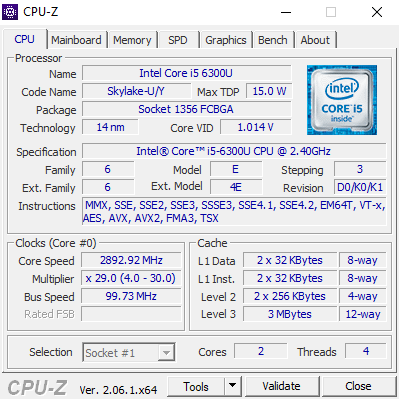Comparing: Intel Core i7 7700K vs Intel Core i5 6300U
In this comparison, we analyze two Processors: Intel Core i7 7700K and Intel Core i5 6300U, using synthetic benchmark tests to evaluate their overall performance. This side-by-side comparison helps users understand which hardware delivers better value, speed, and efficiency based on standardized testing. Whether you're building a new system or upgrading an existing one, this benchmark-driven evaluation offers valuable insights to guide your decision.
Specification Comparison Table
This specification comparison presents technical details of several devices or components to help you understand the key differences between each option. Use this table as a reference to determine which device best suits your needs.
| Specification | Intel Core i7 7700K | Intel Core i5 6300U |
|---|---|---|
| Architecture | x86 | x86 |
| Technology | 14 nm | 14 nm |
| Clock | 4.2 GHz - 4.5 GHz | 2.4 GHz - 3 GHz |
| Core/Thread | 4 / 8 | 2 / 4 |
| Segmen | Desktop | Mobile |
Submission Comparison Table
This submission comparison table displays the number and details of benchmark data submissions from various devices or components. This information helps you understand the performance based on the benchmarks that have been tested, as well as providing an overview of the consistency and popularity of the available benchmark results.
| No. | Benchmark Software | Intel Core i7 7700K | Intel Core i5 6300U |
|---|---|---|---|
| 1 | Cinebench - 2003 |
4315 cb |
1601 cb |
| 2 | Cinebench - R11.5 |
9.59 pts |
2.91 pts |
| 3 | Cinebench - R15 |
867 cb |
262 cb |
| 4 | Cinebench - R20 |
2222 pts |
656 pts |
| 5 | PiFast |
14sec, 730ms |
23sec, 10ms |
| 6 | SuperPi - 1M |
30sec, 414ms |
12sec, 607ms |
Submission Comparison Chart
This chart visualizes the benchmark scores comparison between two hardware devices based on submitted data.
Media Gallery
A collection of photos of tested hardware. These images can help you identify the physical form, model, and variant of the hardware in question. These photos are from our own documentation, and if they are not available we may not be able to document them.
About Hardware Intel Core i7 7700K
The Intel Core i7-7700K, launched in early 2017, is a high-performance desktop processor from the 7th generation Kaby Lake family. Built on the 14nm process, the i7-7700K features 4 physical cores and 8 threads, thanks to Hyper-Threading Technology, and is targeted at enthusiasts, gamers, and power users. It operates at a base frequency of 4.2 GHz and can boost up to 4.5 GHz via Intel Turbo Boost, delivering excellent single-threaded performance one of the highest at the time of its release.
As part of Intel’s “K” series, the Core i7-7700K has an unlocked multiplier, making it ideal for overclocking on compatible Z-series motherboards. However, with a TDP of 91W, the processor demands an effective cooling solution, especially when overclocked beyond its stock speeds. Users typically pair this CPU with aftermarket air or liquid coolers to ensure thermal stability under heavy workloads or gaming sessions.
The processor includes Intel HD Graphics 630, which supports 4K output at 60Hz and is sufficient for basic tasks like web browsing, video playback, and office work. However, for serious gaming or GPU-accelerated workloads, a discrete graphics card is still necessary, especially when paired with a high-refresh-rate monitor or demanding software.
In terms of real-world performance, the i7-7700K remains capable even today for 1080p and 1440p gaming, general productivity, and creative tasks. It delivers solid frame rates in many modern titles when used with a modern GPU, and it handles applications like Adobe Photoshop, Premiere Pro, and coding environments reasonably well. However, due to its limited core count by today’s standards and lack of PCIe 4.0 support, it has started to show its age in multi-threaded and next-gen workloads.
Despite being surpassed by newer Intel and AMD CPUs with more cores and better efficiency, the i7-7700K still holds value in many mid-range desktop setups, especially for users who already own an LGA 1151 system and want to maximize performance without a full platform upgrade.
Thursday, 23 June 2022 07:42:37 | Update: 1 month ago
About Hardware Intel Core i5 6300U
The Intel Core i5-6300U is a dual-core, quad-thread mobile processor that belongs to Intel’s Skylake generation, released in 2015. Designed with power efficiency in mind, the i5-6300U operates at a base clock speed of 2.4 GHz and can dynamically boost up to 3.0 GHz thanks to Intel’s Turbo Boost technology. Built on a 14nm manufacturing process, this processor has a low thermal design power (TDP) of just 15 watts, making it ideal for ultrabooks and slim laptops where battery life and heat management are crucial. The chip features integrated Intel HD Graphics 520, which supports smooth 4K video playback and can handle light gaming and everyday graphical tasks, making it suitable for casual multimedia users.
In practical use, the i5-6300U offers reliable performance for common activities such as web browsing, office productivity software, video streaming, and basic photo editing. It is commonly found in business laptops like the Lenovo ThinkPad T470, equipped with 8GB DDR4 RAM and running Windows 10, providing a smooth user experience for professionals and students alike. Despite its strengths, the i5-6300U’s performance in modern multi-threaded applications and gaming falls behind newer processors due to its limited cores and older architecture. Nevertheless, it remains a solid choice for users prioritizing energy efficiency and portability over raw computing power.
Overall, the Intel Core i5-6300U continues to be a dependable processor in the used laptop market and legacy systems, delivering a good balance of performance and power consumption for everyday computing tasks, especially in ultrabook designs where efficiency is key.
Hardware Detail:
Device: Lenovo ThinkPad T470
RAM: 8GB DDR4 Single Channel
OS: Windows 10
Thursday, 10 August 2023 10:15:48 | Update: 1 month ago



